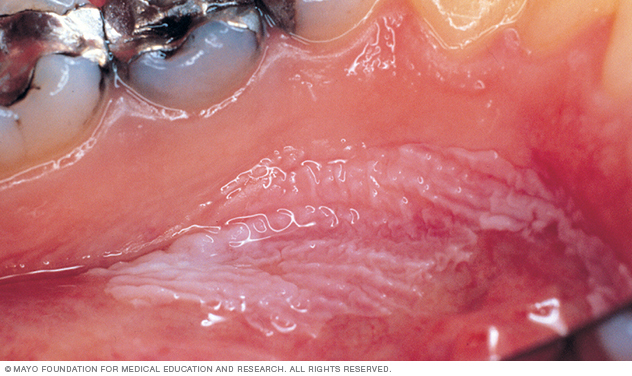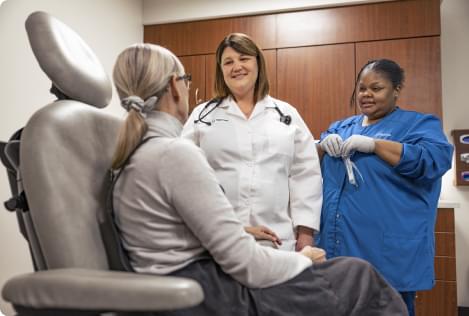Overview
Leukoplakia (loo-koh-PLAY-key-uh) causes thick, white patches that form on the gums. The patches also may form on the insides of the cheeks and the bottom of the mouth. Sometimes the patches form on the tongue. These patches cannot be scraped off.
Doctors do not know the exact cause of leukoplakia. But ongoing irritation from tobacco — whether smoked, dipped or chewed — may be the most common cause. Long-term alcohol use is another possible cause.
Most leukoplakia patches are not cancer. But some patches show early signs of cancer. Cancers in the mouth can occur next to areas of leukoplakia. White areas mixed with red areas, also called speckled leukoplakia, may possibly lead to cancer. It's best to see your dentist or doctor if you have any changes in your mouth that do not go away.
A type of leukoplakia in the mouth called hairy leukoplakia mainly affects people whose immune systems have been weakened by disease, especially HIV/AIDS.

Symptoms
Leukoplakia usually occurs on the gums, the insides of the cheeks, the bottom of the mouth under the tongue and, sometimes, the tongue. Usually it is not painful and it may not be noticed for a while.
Leukoplakia may appear as:
- White or gray patches that cannot be wiped away.
- Patches with a rough, ridged, wrinkled or smooth surface, or a combination of these.
- Patches with shapes and edges that are not regular.
- Thick or hard patches.
White patches of leukoplakia may appear along with raised, red areas called erythroplakia (uh-rith-roe-PLAY-key-uh). This combination is called speckled leukoplakia. These patches are more likely to show changes that may lead to cancer.
Hairy leukoplakia
Hairy leukoplakia causes fuzzy, white patches that look like folds or ridges. The patches usually form on the sides of the tongue. Hairy leukoplakia is often mistaken as oral thrush, an infection that causes creamy white patches that can be wiped away. Oral thrush also is common in people with weak immune systems.
When to see a doctor
Even though leukoplakia does not usually cause discomfort, sometimes it can suggest a more serious condition.
See your doctor or other healthcare professional if you have any of these:
- White patches or sores in the mouth that do not heal on their own within two weeks.
- Lumps in the mouth.
- White, red or dark patches in the mouth.
- Changes in the inside of the mouth that do not go away.
- Ear pain.
- Problems swallowing.
- Problems opening the jaw.
Causes
The exact cause of leukoplakia is not known. But long-term irritation from tobacco use — smoked and smokeless — appears to be strongly related to many cases. Often, regular users of smokeless tobacco products get leukoplakia in places where they hold the tobacco between their gums and cheeks.
The use of betel nut, also called an areca nut, may be a cause of leukoplakia. A betel nut packet, like smokeless tobacco, is held between the gum and cheek.
Other possible causes may include ongoing irritation from:
- Long-term, heavy alcohol use.
- Jagged, broken or sharp teeth rubbing on tongue surfaces.
- Broken dentures or dentures that do not fit well.
Your doctor or other healthcare professional can talk with you about what may be causing leukoplakia.
Hairy leukoplakia
Hairy leukoplakia results from infection with the Epstein-Barr virus (EBV). Once you've been infected with EBV, the virus remains in your body for life. Usually the virus is not active and does not cause symptoms. But if your immune system is weakened, especially from HIV/AIDS, the virus can become active. This can lead to conditions such as hairy leukoplakia.
Risk factors
Tobacco use, particularly smokeless tobacco, puts you at high risk of leukoplakia and mouth cancer. Long-term, heavy alcohol use increases your risk. Drinking alcohol combined with using tobacco increases your risk even more.
Hairy leukoplakia
People with HIV/AIDS are especially likely to develop hairy leukoplakia. The use of medicines that slow down or prevent HIV activity has reduced the number of people who get hairy leukoplakia. But it still affects many people who are HIV positive. It may be one of the early signs of HIV infection.
Complications
Leukoplakia usually does not cause permanent damage to the inside of the mouth. But leukoplakia increases the risk of mouth cancer. Mouth cancers often form near leukoplakia patches. And the patches themselves may show cancerous changes. Even after leukoplakia patches are removed, the risk of mouth cancer remains.
Hairy leukoplakia
Hairy leukoplakia is not likely to lead to cancer. But it may be an early symptom of HIV/AIDS.
Prevention
You may be able to prevent leukoplakia if you avoid all tobacco products or alcohol use. Talk to your doctor or other healthcare professional about ways to help you quit. If you continue to smoke or chew tobacco or drink alcohol, have dental checkups often. Mouth cancers are usually painless until advanced. Quitting tobacco and alcohol is a better way to prevent mouth cancers.
Hairy leukoplakia
If you have a weak immune system, you may not be able to prevent hairy leukoplakia. But finding it early can help you get proper treatment.
Diagnosis
Most often, your doctor, dentist or other healthcare professional will find out if you have leukoplakia by:
- Looking at the patches in your mouth.
- Trying to wipe off the white patches.
- Talking about your medical history and risk factors.
- Ruling out other possible causes.
Testing for cancer
If you have leukoplakia, your doctor will likely test a sample of cells in your mouth for early signs of cancer, called a biopsy:
- Oral brush biopsy. In this test, cells are removed from the surface of the patch with a small, spinning brush. This test does not always give a definite diagnosis.
- Excisional biopsy. In this test, a small piece of tissue is removed from the leukoplakia patch. If the patch is small, the entire patch may be removed. An excisional biopsy usually results in a definite diagnosis.
If the biopsy shows cancer and your doctor removed the entire leukoplakia patch with an excisional biopsy, you may not need more treatment. If the patch is large or if all of it could not be removed, you may need to see an oral surgeon or ear, nose and throat (ENT) specialist for treatment.
Hairy leukoplakia
If you have hairy leukoplakia, you'll likely be checked for conditions that may cause a weakened immune system.
Treatment
Leukoplakia treatment is most successful when a patch is found and treated early, when it's small. Regular checkups are important. So is checking your mouth regularly for changes to your cheeks, gums and tongue.
For most people, getting rid of the source of irritation — such as stopping tobacco or alcohol use — clears the condition.
When these lifestyle changes do not work or if the patch shows early signs of cancer, the treatment plan may include:
- A surgery to remove the leukoplakia patches. Patches may be removed using a small surgical knife. A laser, a tool that uses heat, or a tool that uses extreme cold also can remove the patch and destroy cancer cells.
- Follow-up visits to check the area. Once you've had leukoplakia, it's common for it to come back.
Treating hairy leukoplakia
Usually, you do not need treatment for hairy leukoplakia. The condition often causes no symptoms and is not likely to lead to mouth cancer.
If your doctor or other healthcare professional recommends treatment, it may include:
- Medicine. You may take pills, such as antiviral medicines. These medicines can keep the Epstein-Barr virus, the cause of hairy leukoplakia, under control. Treatment that is put directly on the patch also may be used.
- Follow-up visits. Once you stop treatment, the white patches of hairy leukoplakia may come back. Your doctor may recommend regular follow-up visits to look for changes in your mouth.
Preparing for an appointment
You're likely to start by seeing your doctor, dentist or other healthcare professional. You may be referred to an oral surgeon or an ear, nose and throat (ENT) specialist for diagnosis and treatment.
What you can do
To get ready for your appointment, make a list of:
- Your symptoms, even if they do not seem related to your condition.
- Key medical and dental information, such as past symptoms and treatment, if any.
- All medicines, vitamins, herbal remedies and other supplements that you take, including the doses.
- Questions to ask to make the most of your appointment time.
Some basic questions to ask include:
- What is likely causing my condition?
- Are there other possible causes for my condition?
- Do I need special tests?
- Is my condition likely short-term or long-term?
- What treatments are there? Which do you recommend?
- Are there other options than the approach that you're suggesting?
- Are there any restrictions I need to follow?
- Do you have any printed materials that I can have? What websites do you recommend?
Feel free to ask other questions during your appointment.
What to expect from your doctor
Your doctor or other healthcare professional is likely to ask you questions, including:
- When did you first notice these changes in your mouth?
- Do you have any pain or bleeding from the problem area?
- Do you smoke?
- Do you use chewing tobacco?
- How much alcohol do you drink?
- Do you have any trouble swallowing?
- Have you noticed any lumps or bumps in your neck?
- Do you have any pain?
- Do you have any areas of numbness on your tongue or lip?
© 1998-2024 Mayo Foundation for Medical Education and Research (MFMER). All rights reserved. Terms of Use


